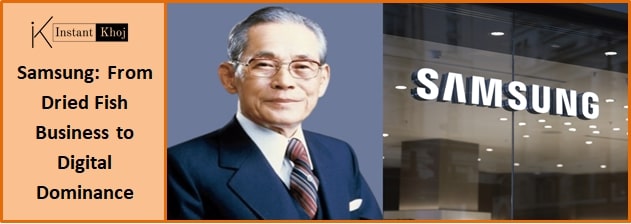Humble Beginnings in 1930s Korea
When people hear the name Samsung today, they often picture sleek smartphones, high-end TVs, or cutting-edge displays. But long before it became a global technology leader, Samsung’s roots were far more modest. Its origin wasn’t in semiconductors or software—but in selling dried fish, noodles, and basic groceries in a small Korean town during the 1930s. What followed over the next several decades was a remarkable story of reinvention, risk-taking, and resilience that would eventually make Samsung one of the most recognized brands in the world.
The Birth of Samsung Sanghoe
The company’s story began in 1938, when Lee Byung-chul, the son of a wealthy landowner, opened a small trading business in Daegu, Korea. He called it Samsung Sanghoe, meaning “Three Stars,” a name that symbolized greatness and longevity. The company originally sold local produce, dried seafood, and household goods. Korea was still under Japanese occupation at the time, and the country’s economy was fragile. But Lee believed commerce could help build a stronger national foundation. Even as war and hardship gripped the country, he kept expanding, eventually growing the business into areas like textiles, sugar production, and insurance. By the 1960s, Samsung was becoming a major industrial force within Korea.
Entering the Electronics Era
In 1969, Samsung made its move into electronics—a decision that would shape its identity for generations to come. Its first product was a basic black-and-white TV. At that time, Korea had little experience with electronics manufacturing, but Samsung saw opportunity where others saw risk. The company partnered with Japanese firms to gain early technical expertise, while also building its own factories and engineering capabilities. By the 1970s and 80s, Samsung was producing everything from household appliances to microwaves and audio equipment.
The Semiconductor Gamble
But one of Samsung’s most pivotal bets came in the semiconductor industry. In the early 1980s, it opened its first chip-making plant, at a time when very few companies were willing to enter such a capital-intensive and complex field. Lee believed that building memory chips and processors would be key to Korea’s future competitiveness. The gamble paid off. Over the next two decades, Samsung became a dominant player in global memory and display production.
The Lee Kun-hee Era: Quality Over Quantity
When Lee Byung-chul passed away in 1987, his son Lee Kun-hee took the helm. He didn’t just want Samsung to be big—he wanted it to be great. In the early 1990s, he launched a complete overhaul of the company’s culture and quality standards. One of his most famous speeches, delivered to executives in Germany, challenged them to “change everything except your wife and children.” This wasn’t empty rhetoric. Samsung began destroying defective products in bulk, revamping design processes, and investing heavily in R&D and global branding. It wasn’t just about catching up to companies like Sony—it was about surpassing them.
Becoming a Consumer Electronics Powerhouse
In the 2000s, Samsung shifted from being a component supplier to a consumer-facing brand. It launched stylish flip phones, entered the smartphone race, and became a leader in LCD and OLED TV technologies. The Galaxy smartphone line, introduced in 2010, quickly positioned Samsung as a serious competitor to Apple. While some criticized its early devices for imitating the iPhone, Samsung soon carved out its own identity by embracing larger screens, styluses, and experimental designs. In many regions, it became the top smartphone brand, particularly in Asia and emerging markets.
Facing Challenges and Reinventing Again
Even as its mobile division thrived, Samsung continued pushing boundaries in areas like chipmaking, home appliances, and digital displays. Its semiconductors powered devices made by rivals, and its TV innovations set the standard for picture quality. Alongside this growth, however, came public scrutiny. The company faced setbacks like the Galaxy Note 7 recall in 2016 and legal troubles involving executive leadership. Yet through these challenges, Samsung doubled down on quality, trust, and long-term investment.
Looking to the Future with AI and Sustainability
In recent years, Samsung has turned its attention toward the future. It has led the way in foldable smartphones, smart home integration, and artificial intelligence. In 2023, it introduced Galaxy AI, offering real-time translation, creative tools, and enhanced productivity features powered by generative AI. It has also pledged strong climate goals, including a net-zero carbon target and increased use of recycled materials across its product lines. Behind the scenes, it continues to lead in high-performance memory and chip production—crucial to supporting global demand for AI, cloud computing, and advanced mobile experiences.
Final Thoughts: A Relentless Drive to Lead
Samsung’s journey—from a small trade shop selling noodles to a world leader in electronics—is a powerful example of what vision, reinvention, and persistence can achieve. It has weathered wars, economic crises, and corporate transitions while remaining a symbol of South Korea’s industrial rise. Its future may involve AI, 6G, or quantum computing—but the company’s core remains the same: a relentless push to improve, adapt, and lead.
Read more articles like this — Click here to explore now





2 thoughts on “Samsung: From Dried Fish Business to Digital Dominance”